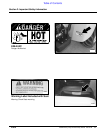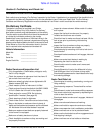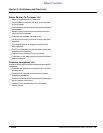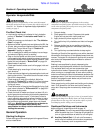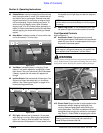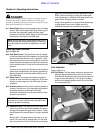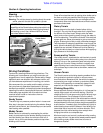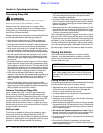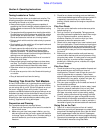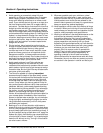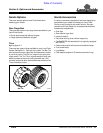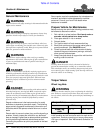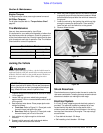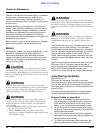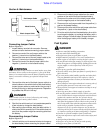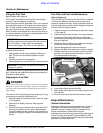
6/30/05
19
Section 4: Operating Instructions
4400EX Heavy Duty Off Road Utility Vehicle 720-051M
Table of Contents
Towing Loaded on a Trailer
The Gondo may be driven or winched onto a trailer. The
following precautions should be followed when loading
and towing the Gondo on a trailer:
• Always make certain loading ramps are capable of
supporting the Gondo’s weight, properly spaced for the
Gondo wheels and secured to the trailer before loading
the Gondo.
• Two people should be present when loading the vehicle.
One stands clear of the Gondo as he guides the vehicle
up the ramps and onto the trailer. The other sits in the
Gondo and steers the vehicle as it is being loaded.
• Drive or winch vehicle onto the trailer slowly to prevent
accidents.
• Once loaded, turn the switch key off, set park brake and
place transmission in 1st gear.
• Properly secure the vehicle at its four corners to the four
corners of the trailer with tie down chains or other
approved tie downs. Tie downs must be designed to
withstand forces induced into them during acceleration,
making turns and applying brakes.
• Always tow at a speed where the driver is in control of
his vehicle at all times.
• Always allow enough traveling distance to slow down
and stop. The Gondo’s added weight to the trailer will
require additional time and distance to slow down.
• Slow down when turning to prevent loss of control and
rollovers.
• Do not allow anyone to ride in the Gondo while towing it
on a trailer.
• Obey all state and local laws for towing.
Traveling Tips From the Trail Masters
At Land Pride we want you to get maximum working and
recreational enjoyment out of your utility vehicle whether
you are using one of our All-Terrain Runabouts or one of
our terrain hugging Gondo utility trucks. If your work
project or recreational adventure is going to take you on an
extended ride deep into the wilderness or way out on the
prairie, you’ll need to seriously consider some of the
following tips from experienced pros about safety, gear,
clothing, supplies and driving techniques.
Preparation and Planning
Do a complete equipment check as follows:
1. Make sure you have plenty of fuel and oil to make the
trip and then some.
2. Make sure your tires have proper inflation, your lug
bolts are tight and that you have a spare and the tools
to change, repair and inflate a tire. Consider adding a
puncture sealant to your tires as a preventative
measure.
3. Check for any loose or missing parts and definitely
make those needed repairs before going anywhere. It
is especially important that you check steering,
braking, throttle, electrical and engine components
thoroughly.
Plan Your Route
1. Plan your route, destination and rendezvous points
before starting out.
2. Don’t go it alone if at all possible. Taking someone
else along reduces the potential for loss of life or major
injury to inclement weather, animal attacks, or
accidents. Besides, it’s more fun when you have
someone to share the adventure with.
3. Obtain trail or area maps of your travel routes to and
from your destination. Communicate your travel plans
to responsible friends and or proper authorities. Plan
rendezvous points at conspicuous landmarks along
your route just in case you run into unexpected trouble
on the trail.
4. Make sure you take a weather radio and two-way
communication devices such as cell phones or long
range-two way radios. It is also good to have ground
flares, a flare gun, a smoke canister, emergency
strobe light, a reflecting mirror, matches for a signal
fire and a compass.
Plan Your Gear
1. Check the short and long range weather forecast and
take protective gear and clothing to cover all
contingencies. It doesn’t have to snow for you to fall
victim to hypothermia or exposure. Take or wear
appropriate eye and head protection, gloves, boots, a
long sleeve shirt, long pants, a jacket, rain gear, dry
socks and a full change of dry clothing.
2. Plan your gear and gear up for the best and worst of
environmental conditions.
3. Pack a first aid kit, sunblocker, lip balm, water, insect
repellent, personal medications, tarp or tent, flash
light, survival knife, binoculars, camera, tool kit, rope,
duct tape, tow strap, winch or come-along, eating,
utensils, cooking utensils and high energy trail food.
4. Tie and lash down your gear and supplies securely.
Keep the bulk of the weight centered and mounted as
low as possible on the vehicle in order to maintain a
low center of gravity for safe and stable off-road travel.
Going Out on the Trail
1. Take it all in when hitting the trail but do it safely!
2. Make sure you brief your passenger on proper safety
procedures like keeping hands, arms, feet and other
bodily appendages inside the vehicle. Passengers
should only be transported in factory supplied seating.
3. Operator and passenger are responsible for deciding
if their situation warrants using Seat Belts.



